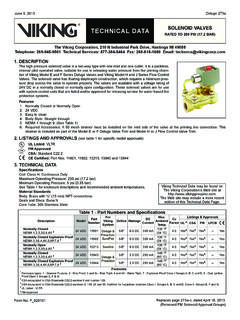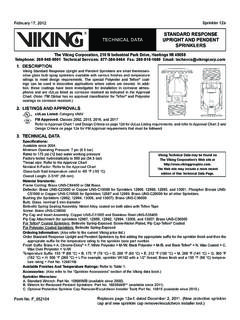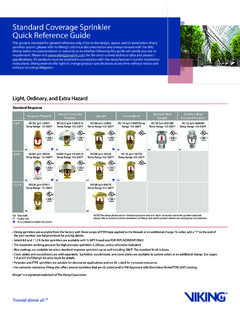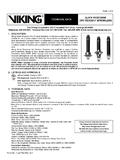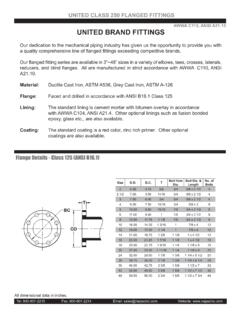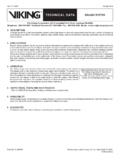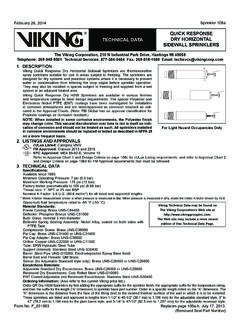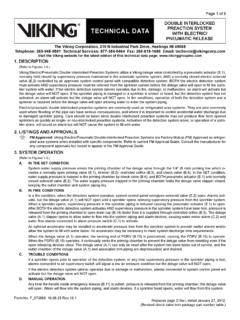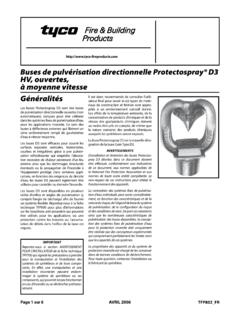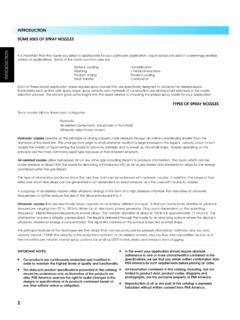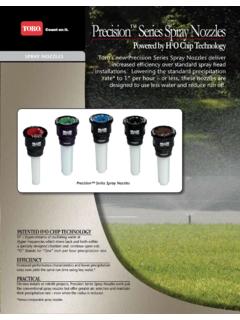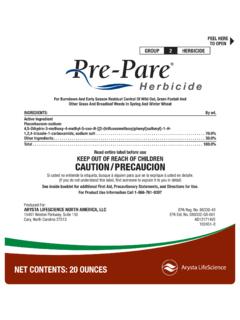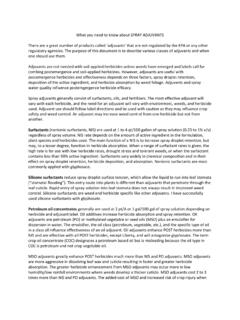Transcription of Spray Nozzles Selection for Water Spray Systems
1 Spray Nozzles Selection for Water Spray SystemsScott Martorano, CFPS, Senior Manager Technical ServiceMarch 2007 Technical ArticleWater Spray Systems as defined in NFPA 15 can provide some of the most complex and challenging system designs encountered by fire protection professionals. The Selection of the proper Spray nozzle that achieves the coverage area and Water density required for the hazard being protected is one of the most important steps necessary to ensure the successful operation of the system. Of course, there are many other steps of equal importance and complexity that are taken during the design and layout process for Water Spray Systems , but it is the Selection of the proper Spray Nozzles that can present one of the largest challenges and may ultimately determine whether or not the Water Spray system will perform as required.
2 Because of the wide variations in the characteristics of Water Spray Nozzles including discharge patterns, velocities, distances of projection and the variables of the hazards being protected, a careful evaluation of the nozzle Selection should be completed by a professional with an in-depth knowledge of special hazards applications and Water Spray system design. The complexity of nozzle Selection can be increased in some cases where a limited amount of technical information is available de-scribing the specific features or proper application for the Spray nozzle being considered. In other cases, confusion may result from the terminology used in a manufacturer s technical data, such as high, medium and low velocity Nozzles and the term velocity s rela-tionship to the application.
3 Given the substantial number of hazards where Spray Nozzles can be applied, and the various listings and approvals granted by Underwriters Laboratory, Factory Mutual and LPCB, the design engineer and layout technician are presented with a demanding Selection process. This paper will attempt to clarify Spray nozzle Selection criteria for several of the most complex Water Spray applications and the terminology used to identify the unique characteristic of the Spray Spray and NozzlesThe applications where Spray Nozzles are utilized can be severe. Primarily Spray Nozzles are used for exposure protection of bulk storage flammable and combustible liquid tanks to cool the shell, prevent explosion or collapse of the tank and extension of the fire.
4 In addition, when designed properly and correctly installed Water Spray Systems can be successfully utilized for extinguishment and control of some flammable liquids fires, some combustible liquid fires, Class A combustibles, and electrical transformer applications. Extinguishment of a fire using Water Spray is achieved by cooling, smothering, emulsifying or diluting of flammable liquids or by a combination of these factors. 1 Controlling of a fire can be achieved with the same mechanisms that achieve extinguishment, how-ever due to different characteristics of the fuel, suppression is not possible. 2 Picture: Electrical Transformer FireFM Global defines the mechanisms of fire extinguishment in the following manner:Cooling action results to some extent from absorption of heat by Water particles but mostly from the conversion of Water to steam.
5 When converted into steam, 1lb of Water at 60OF absorbs 1150 Btu. When the surface of the burning material is cooled to a point where flammable vapors are no longer evolved, the fire is action is obtained when the Water Spray is converted to steam by the heat of the fire, expanding its volume approxi-mately 1,750 times. As the steam envelops the fire area, oxygen is excluded which helps to extinguish the is obtained by mechanical agitation of Water with oil or other non- Water soluble liquids so that droplets of both Viking Technical ArticleSpray Nozzles Selection for Water Spray Systems2materials become closely interspersed. Such an emulsion is produced by the action of Water Spray striking the surface of certain flammable liquids, rendering the liquid surface nonflammable.
6 With liquids of low viscosity, emulsification is probably tempo-rary, existing only during the application of the Spray . With materials of higher viscosity, the emulsion will last longer and provide some protection against of Water -soluble liquids is usually a minor factor in extinguishing a fire because of the high degree of dilution nozzle Selection and OperationThe Selection of Spray Nozzles involves consideration of several factors, primarily their ability to distribute Water in a manner which allows the proper mechanism of extinguishment or control for the hazard to be achieved. Spray Nozzles are available in a wide range of capacities and angles.
7 The design elements used within the Spray nozzle to manipulate the movement of Water through the Spray nozzle will impact the discharge velocity of the Water droplets and the discharge pattern s reach or range. The velocity of the Water droplets discharged from Spray Nozzles is not a factor for consideration of Water Spray system design within NFPA 15 or 13. However, terms referencing velocity are used extensively within manufacturer s technical data and within the testing and installation standards of the Loss Prevention Certification Board (LPCB) which are used in many parts of the world. The exact meaning of this terminology and how it applies to the Spray nozzle application can be confusing and at times misleading, but it can be helpful to put a definition to the terms low, medium and high velocity if for no other reason than to help the designer and layout technician gain a better understanding of the nozzle application.
8 The only written definitions for Spray Nozzles that can be found within the fire protection industry commonly referenced text are within the LPCB Standard 1277. LPCB Standard 1277 defines medium velocity Spray Nozzles as sprayers with deflection plates producing conical discharge pat-terns having bores not less that inch ( mm) and meeting the test requirements of this standard apart from the fire test. These sprayers may be opened or sealed; the seal is identical to that of a sprinkler and sprayers with swirl chambers producing conical discharge patterns and having internal waterways not less than 1/8 inch ( mm) and final exit bores not less than inch ( mm) and meeting the requirements of this standard at a pressure of 20 psi ( bar) apart from the fire test.
9 High velocity Spray Nozzles are defined as sprayers with swirl chambers producing conical discharge patterns and having internal waterways not less than 1/8 inch ( mm) and final exit bores not less than inch ( mm) and meeting the requirements of this standard apart from those for cone angles and distribution. 4 From these definitions several of the key differences between medium and high velocity Spray Nozzles can be identified; for instance, the incorporation of a deflector on some medium velocity Nozzles and high velocity Nozzles will have to meet different cone angle and distribution requirements. Also the term swirl chamber is introduced for some medium velocity and all high velocity Nozzles .
10 A swirl chamber is used within a nozzle to spin the Water so it emerges as a solid cone , the term velocity and distribution of the size of Water droplets has been understood to describe the reach or area of coverage of the nozzle s Water Spray However, it is the velocity and dispersion of the Water droplets themselves which will determine a Spray nozzle s ability to achieve the mechanisms of extinguishment or control of a fire. Fixed Nozzles have certain velocity or pressure ranges of effectiveness. Below the lower limit of the force range, the discharge pat-tern is ineffective; above the upper limit, velocities may be reached that will result in decreased effectiveness due to reduction in the discharge pattern, delivery distance and/or the Water At the point where a droplet of Water is discharged from a nozzle , it is carried forward by its momentum, downward by the force of gravity, and is retarded by friction in the air.

